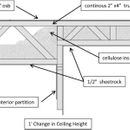Thermal Bypass at Change in Ceiling Height
Is there a thermal bypass in a wall where the ceiling height changes and the insulation in the ceiling covers the wall completely. See attached drawing.
ED’S NOTE: GUY, I CONVERTED YOUR PDF INTO A JPG SO THAT THE IMAGE COULD BE INCORPORATED INTO THE QUESTION
–DAN
GBA Detail Library
A collection of one thousand construction details organized by climate and house part










Replies
Guy,
Your detail reveals a possible problem with air barrier continuity.
Guy,
There are several ways we do this in the southwest:
1. Install rigid foam between the side cords of the flat trusses all the way up to the roof sheathing and seal or foam-gasket all around.
2. Install a solid air barrier (plywood, sheetrock, rigid foam, thermo-ply, etc) on the left side of the wall between the trusses all the way up to under the roof sheathing, then seal all around with caulk or foam and then come in and blow cellulose on the right side with your cellulose up to the bottom plate of the pony wall. Then spray foam on the rim joist and seal or install rigid form between trusses and seal. To install the required cellulose above the ceiling on flat roofs is quite a chore, besides, they have to net the ceiling, cut 2’x2’ holes to “reach through” and blow the cellulose, which is hard to see if you are doing a good job; specially if your roof trusses are shallow.
3. By the time you do all this work, a much “better” way to do it is to foam the under roof deck with open cell foam and install rigid foam on top of the deck (depending on your climate zone). It’ll be a more consistent coverage, a better seal job and it could be cheaper in the long run because is much less labor intensive.
Here is a slide of my TBP presentation with a similar detail.
I understand that there is a thermal by-pass and it is a critical to seal all six sides as long as the wall is exposed. There must be a depth where the wall, if completely buried below the ceiling insulation, does not create a thermal by-pass.